Corsica & Sardinian – two very popular Mediterranean islands
Wednesday, 28 September 2022In early September with Maureen and 9 other friends we made a boat trip down the west coast of the French island of Corsica and the east coast of the Italian island of Sardinia. I’ve travelled in Corsica on a couple of previous occasions, once walking the GR20 which is often claimed to be the finest walk in Europe. I’d agree!
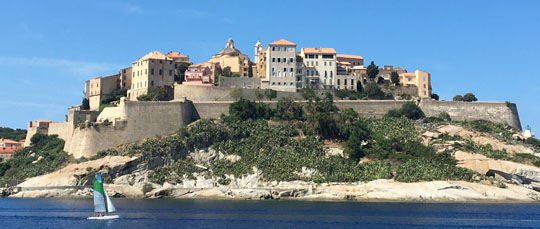 ▲ This time we started in Calvi at the north-west corner of Corsica and dominated by its imposing citadel. There are walls, fortifications, churches and a plaque claiming that this was the birthplace of Christopher Columbus.
▲ This time we started in Calvi at the north-west corner of Corsica and dominated by its imposing citadel. There are walls, fortifications, churches and a plaque claiming that this was the birthplace of Christopher Columbus.
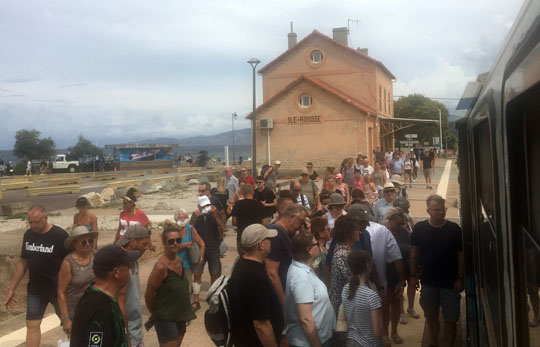 ▲ From Calvi we took the train which runs along the coast to Isla Roussa. It’s exactly as shonky and rough as the Lonely Planet guide suggests. Standing room only as well, but it’s only a 45 minute trip, hugging the coast most of the way and decidedly good fun, looking over beaches, bays, headlands and modern little developments. Lots of train riders use it as transport to the beaches, we just rode to the end of the line and back again.
▲ From Calvi we took the train which runs along the coast to Isla Roussa. It’s exactly as shonky and rough as the Lonely Planet guide suggests. Standing room only as well, but it’s only a 45 minute trip, hugging the coast most of the way and decidedly good fun, looking over beaches, bays, headlands and modern little developments. Lots of train riders use it as transport to the beaches, we just rode to the end of the line and back again.
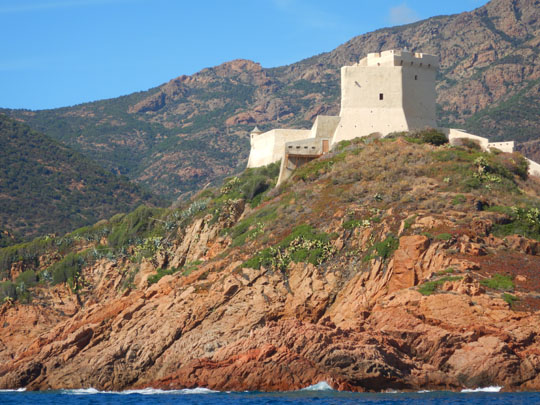 ▲ South from Calvi we stopped at the bay and village of Girolata, which can only be reached by boat or by walking 7km from the nearest road. This fine looking Genoese fort, built in 1551-1552, overlooks the bay from the headland. Genoese lookout towers, built when the City State of Genoa was a major power in this area, are dotted down the coast, built to warn against Barbary pirates. Each lookout tower had to be within sight of the next one along the coast.
▲ South from Calvi we stopped at the bay and village of Girolata, which can only be reached by boat or by walking 7km from the nearest road. This fine looking Genoese fort, built in 1551-1552, overlooks the bay from the headland. Genoese lookout towers, built when the City State of Genoa was a major power in this area, are dotted down the coast, built to warn against Barbary pirates. Each lookout tower had to be within sight of the next one along the coast.
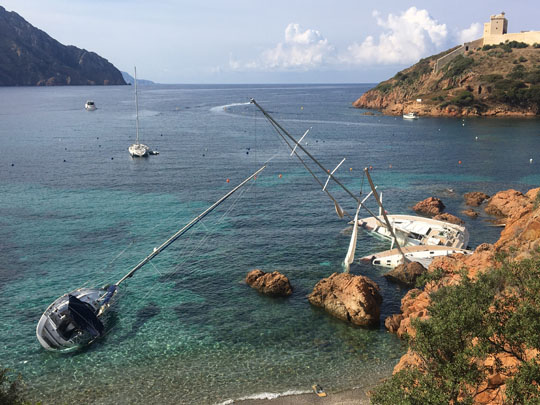 ▲ A week earlier a ferocious storm hit the west coast of Corsica with the highest wind speeds ever recorded in France. Numerous yachts dragged their anchors and were washed up on the beach or rocks. There were five still stranded in this Girolata bay and clearly some of them will never sail again.
▲ A week earlier a ferocious storm hit the west coast of Corsica with the highest wind speeds ever recorded in France. Numerous yachts dragged their anchors and were washed up on the beach or rocks. There were five still stranded in this Girolata bay and clearly some of them will never sail again.
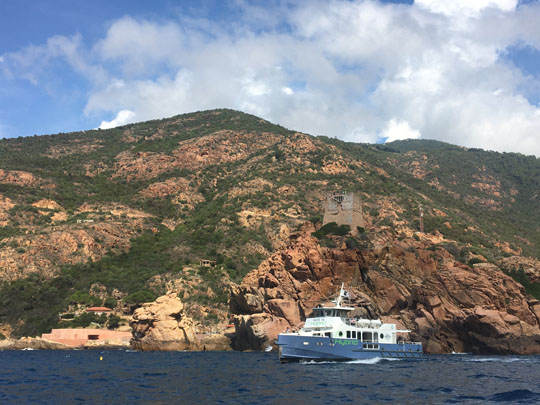 ▲ A few km south at the small port of Porto the entrance is overlooked by another Genoese fortification – a local ferry emerges from the harbour.
▲ A few km south at the small port of Porto the entrance is overlooked by another Genoese fortification – a local ferry emerges from the harbour.
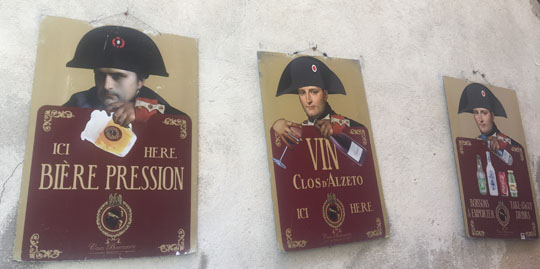 ▲ Ajaccio, the capital of Corsica, was the birthplace of Napoleon Bonaparte and he’s still popular today as these drink ads proclaim. That night we dined ashore in Biboq, a restaurant noted for its lobster spaghetti where we were serenaded by recordings of the music of Tino Rossi, Corsica’s favourite opera singer.
▲ Ajaccio, the capital of Corsica, was the birthplace of Napoleon Bonaparte and he’s still popular today as these drink ads proclaim. That night we dined ashore in Biboq, a restaurant noted for its lobster spaghetti where we were serenaded by recordings of the music of Tino Rossi, Corsica’s favourite opera singer.
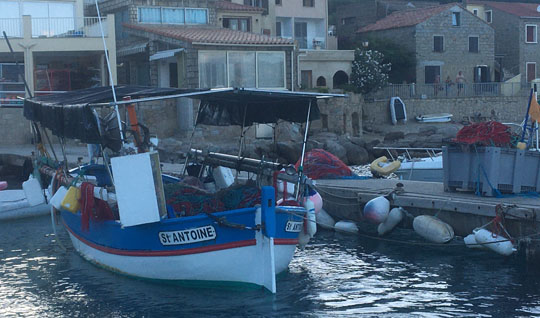
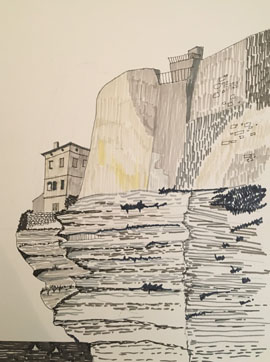 ▲ At Campomoro some of our group went ashore to climb another Genoese tower overlooking the bay.
▲ At Campomoro some of our group went ashore to climb another Genoese tower overlooking the bay.
◄ A regular member of our travel group Barry Munday often produces some sort of art relating to our travels. Like this illustration of Bonifacio, the town at the southern end of Corsica and only a stone’s throw across the strait from Sardinia. The town is perched on a steep and rocky promontory with buildings merging into a sheer drop down to the sea. I took the opportunity to keep my scuba diving hours up by going on a dive off Bonifacio.
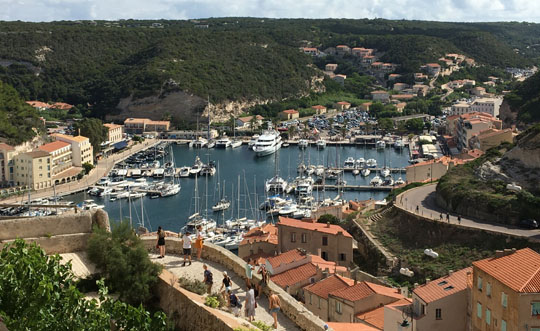 ▲ The other side of the promontory overlooks the town’s picturesque and very busy harbour.
▲ The other side of the promontory overlooks the town’s picturesque and very busy harbour.
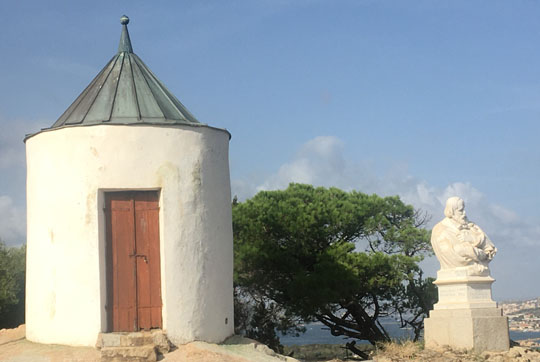 ▲ La Maddalena and Caprere are two islands off the north-east corner of Sardinia. On Isola Caprere I walked to the Compendio di Garibaldi, the home, museum and tomb – he died here in 1882 – of Giuseppe Garibaldi. In between revolutionary activities in South America Garibaldi found time to weld the disparate city states of Italy into the modern Italian nation, as a result he’s a considerable hero in Italy to this day.
▲ La Maddalena and Caprere are two islands off the north-east corner of Sardinia. On Isola Caprere I walked to the Compendio di Garibaldi, the home, museum and tomb – he died here in 1882 – of Giuseppe Garibaldi. In between revolutionary activities in South America Garibaldi found time to weld the disparate city states of Italy into the modern Italian nation, as a result he’s a considerable hero in Italy to this day.
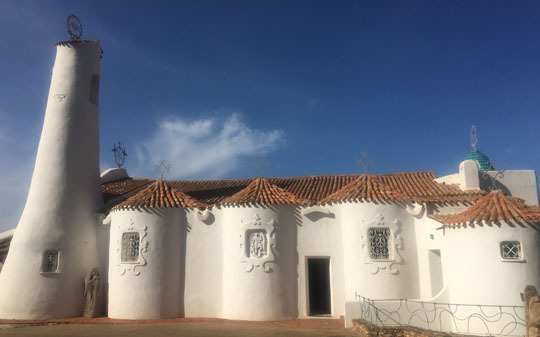 ▲ The north-east corner of Sardinia is known as the Costa Smeralda. It was developed by the Aga Khan from the late ‘60s and is very flash although the disappearance of its rich Russian clientele this year has been a problem. At Porto Cervo some off us walked to the very unusual Stella Maris Church, designed by Michele Busiri Vici and built in 1969.
▲ The north-east corner of Sardinia is known as the Costa Smeralda. It was developed by the Aga Khan from the late ‘60s and is very flash although the disappearance of its rich Russian clientele this year has been a problem. At Porto Cervo some off us walked to the very unusual Stella Maris Church, designed by Michele Busiri Vici and built in 1969.
Lonely Planet describes Porto Cervo as a haven for the super-rich – ‘a kind of Disneyland for Gucci-clad grown-ups.’ We still had a very pleasant dinner by the waterfront that night, where news came through of the Queen’s death in England.
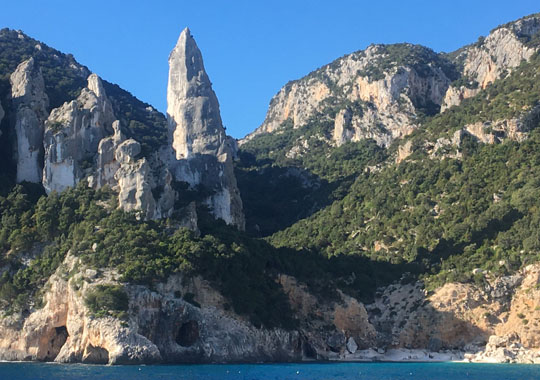 ▲ Further south the absurdly beautiful bay of Cala Goloritzé can only be reached by boat or by walking 3-1/2km from the nearest road. Yes rock climbers do conquer that sheer spire, rocky Aguglia Goloritzé, although unfortunately not while we were there.
▲ Further south the absurdly beautiful bay of Cala Goloritzé can only be reached by boat or by walking 3-1/2km from the nearest road. Yes rock climbers do conquer that sheer spire, rocky Aguglia Goloritzé, although unfortunately not while we were there.
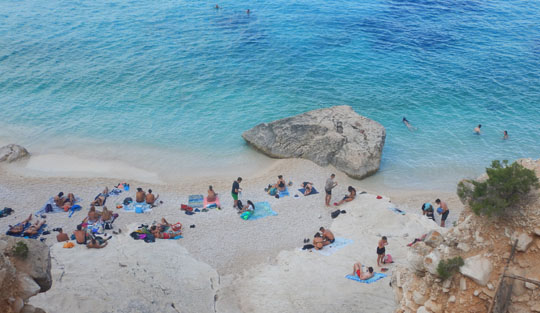 ▲ A view of the Cala Goloritzé beach from the walking path down from the road.
▲ A view of the Cala Goloritzé beach from the walking path down from the road.
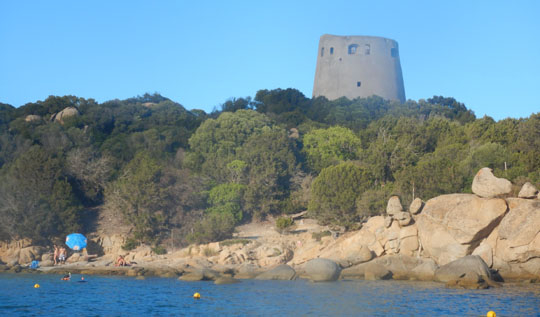 ▲ At Cala Pita another Genoese tower overlooked the beach and the bay, but like most of the other towers we’d visited it wasn’t open.
▲ At Cala Pita another Genoese tower overlooked the beach and the bay, but like most of the other towers we’d visited it wasn’t open.
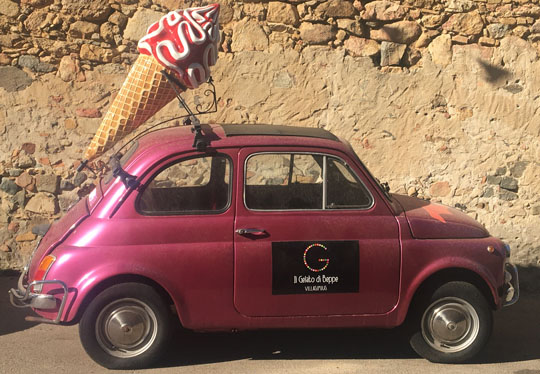
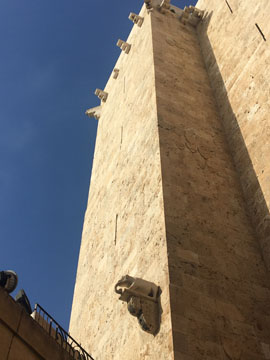 ▲ A reminder, as if you needed one, that ice cream – gelati – is very popular in Italy. Valisimius, where this original Fiat 500 was advertising for one of the local outlets, certainly had plenty of gelateria as well as a Maritime Museum and an Archaeological Museum,
▲ A reminder, as if you needed one, that ice cream – gelati – is very popular in Italy. Valisimius, where this original Fiat 500 was advertising for one of the local outlets, certainly had plenty of gelateria as well as a Maritime Museum and an Archaeological Museum,
◄ The Torre dell’Elefante in Cagliari, the capital of Sardinia at the southern end of the island. Cagliari had lots of museums, galleries and churches. Most of the churches seemed to be closed and locked most of the time. So did the Tower of the Elephant, even though I went there several times, hoping to catch it open.






